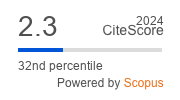THERMAL SCIENCE
International Scientific Journal
Authors of this Paper
External Links
CALCULATION MODEL FOR THE MONTHLY OPTIMAL TILT ANGLE OF FIXED PHOTOVOLTAIC PANELS
ABSTRACT
In photovoltaic systems, the installation tilt angle of modules plays a critical role in determining both performance and economic returns. Existing methods for calculating the optimal tilt angle typically rely on complex solar radiation and anisotropic sky scattering models, which, despite their accuracy, involve intensive computational efforts. Based on the relationships between the proportion of direct radiation, latitude, and the optimal monthly tilt angle, this study proposed a method to calculate the monthly optimal tilt angle. Taking Zhangye City as an example, the accuracy and reliability of the proposed method were verified in comparison with the traditional method. Using this method, the monthly optimal tilt angles were calculated for three cities in China located at different latitudes, to reveal the annual variation patterns of these angles. The results showed that, at the same proportion of direct radiation, the monthly optimal tilt angle increases with latitude. Over the course of a year, the monthly optimal tilt angle first decreases and then increases. In low latitude cites, the monthly optimal tilt angle may even become negative.
KEYWORDS
fixed photovoltaic panel, monthly optimal tilt angle, calculation model, proportion of direct radiation
PAPER SUBMITTED: 2024-08-27
PAPER REVISED: 2024-11-18
PAPER ACCEPTED: 2024-11-27
PUBLISHED ONLINE: 2025-06-01
DOI REFERENCE: https://doi.org/10.2298/TSCI2502403Z
CITATION EXPORT: view in browser or download as text file
PDF VERSION [DOWNLOAD]
2025 Society of Thermal Engineers of Serbia. Published by the Vinča Institute of Nuclear Sciences, National Institute of the Republic of Serbia, Belgrade, Serbia. This article is an open access article distributed under the terms and conditions of the Creative Commons Attribution-NonCommercial-NoDerivs 4.0 International licence

